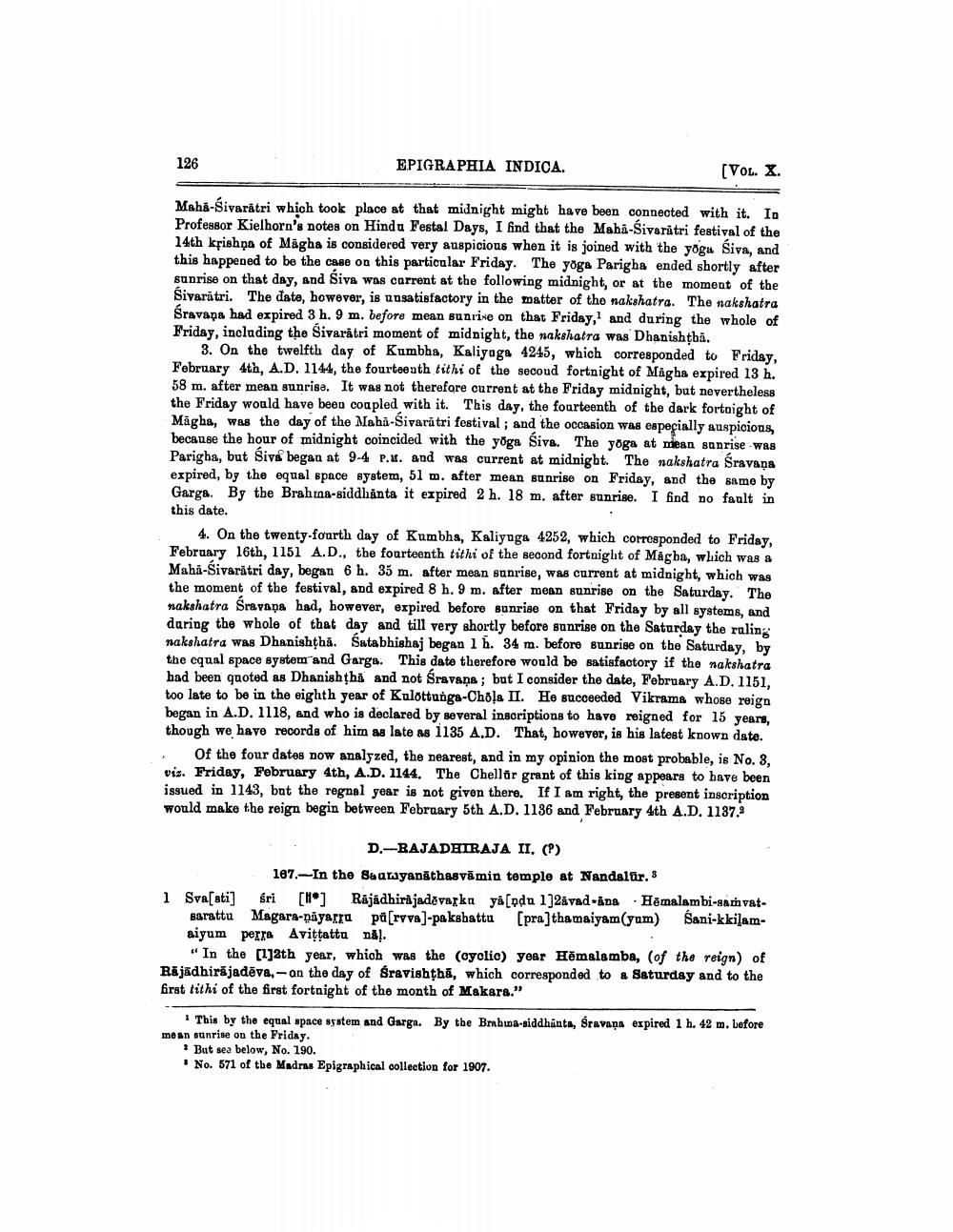________________
126
EPIGRAPHIA INDICA.
[VOL. X.
Maha-Sivaratri which took place at that midnight might have been connected with it. In Professor Kielhorn's notes on Hindu Festal Days, I find that the Maha-Sivaratri festival of the 14th krishna of Magha is considered very auspicious when it is joined with the yoga Siva, and this happened to be the case on this particular Friday. The yoga Parigha ended shortly after sunrise on that day, and Siva was current at the following midnight, or at the moment of the Sivaratri. The date, however, is unsatisfactory in the matter of the nakshatra. The nakshatra Śravana had expired 3 h. 9 m. before mean sunrise on that Friday, and during the whole of Friday, including the Sivaratri moment of midnight, the nakshatra was Dhanishṭhā.
3. On the twelfth day of Kumbha, Kaliyuga 4245, which corresponded to Friday, February 4th, A.D. 1144, the fourteenth tithi of the secoud fortnight of Magha expired 13 h. 58 m. after mean sunrise. It was not therefore current at the Friday midnight, but nevertheless the Friday would have been coupled with it. This day, the fourteenth of the dark fortnight of Magha, was the day of the Maha-Sivaratri festival; and the occasion was especially auspicious, because the hour of midnight coincided with the yoga Siva. The yoga at mean sunrise was Parigha, but Siva began at 9-4 P.M. and was current at midnight. The nakshatra Śravana expired, by the equal space system, 51 m. after mean sunrise on Friday, and the same by Garga. By the Brahma-siddhanta it expired 2 h. 18 m. after sunrise. I find no fault in this date.
4. On the twenty-fourth day of Kumbha, Kaliyuga 4252, which corresponded to Friday, February 16th, 1151 A.D., the fourteenth tithi of the second fortnight of Magha, which was a Maha-Sivaratri day, began 6 h. 35 m. after mean sunrise, was current at midnight, which was the moment of the festival, and expired 8 h. 9 m. after mean sunrise on the Saturday. The nakshatra Śravana had, however, expired before sunrise on that Friday by all systems, and during the whole of that day and till very shortly before sunrise on the Saturday the ruling nakshatra was Dhanishtha. Śatabhishaj began 1 h. 34 m. before sunrise on the Saturday, by the equal space system and Garga. This date therefore would be satisfactory if the nakshatra had been quoted as Dhanishtha and not Sravana; but I consider the date, February A.D. 1151, too late to be in the eighth year of Kulottunga-Chola II. He succeeded Vikrama whose reign began in A.D. 1118, and who is declared by several inscriptions to have reigned for 15 years, though we have records of him as late as 1135 A.D. That, however, is his latest known date.
Of the four dates now analyzed, the nearest, and in my opinion the most probable, is No. 3, viz. Friday, February 4th, A.D. 1144. The Chellar grant of this king appears to have been issued in 1143, but the regnal year is not given there. If I am right, the present inscription would make the reign begin between February 5th A.D. 1136 and February 4th A.D. 1137.3
"
D.-RAJADHIRAJA II. (?)
187.-In the Saurayanathasvamin temple at Nandalür.
1 Sva[sti] śri [*] Rajadhirajadē varku ya [pdu 1]2avad-ana Hemalambi-samvatsarattu Magara-nayarru på[rvva]-pakshattu [pra] thamaiyam (yum) Sani-kkilamaiyum perra Avittattu nal.
"In the [1]2th year, which was the (cyclic) year Hemalamba, (of the reign) of Rajadhirajadeva, -on the day of Sravishṭha, which corresponded to a Saturday and to the first tithi of the first fortnight of the month of Makara."
This by the equal space system and Garga. By the Brahma-siddhanta, Sravana expired 1 h. 42 m. before mean sunrise on the Friday.
But sea below, No. 190.
No. 571 of the Madras Epigraphical collection for 1907.




